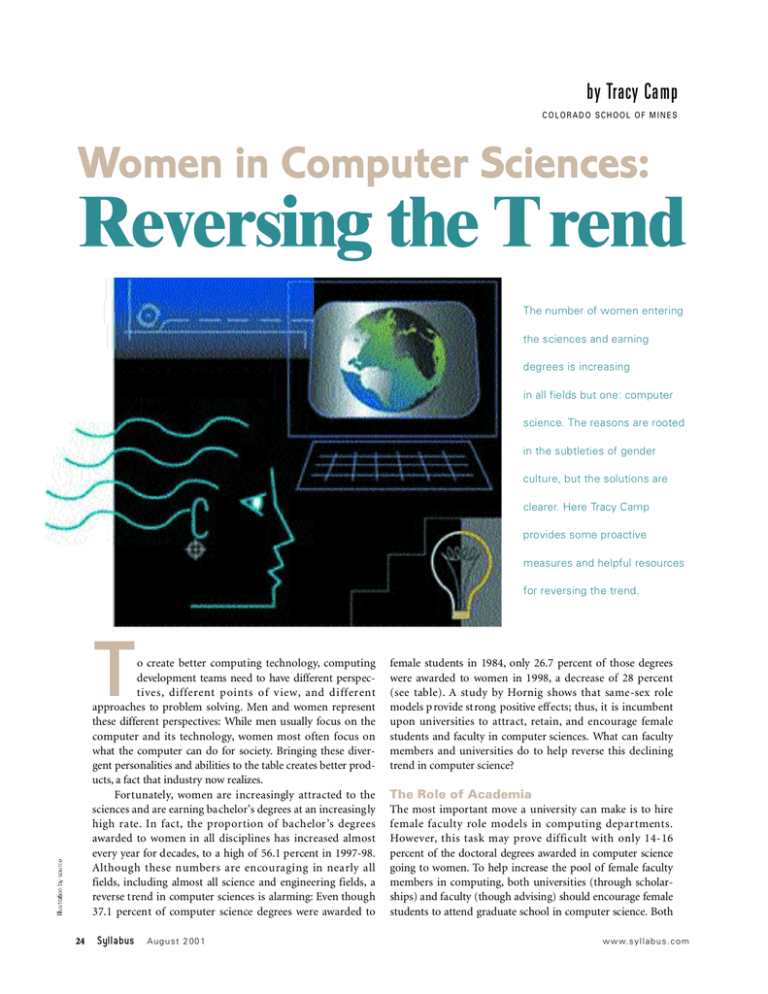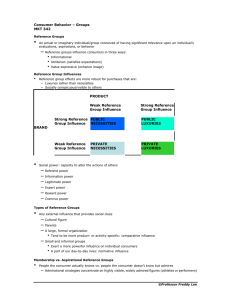Reve rsing the T re n d - Carnegie Mellon School of Computer Science
advertisement

by Tr a cy Camp C OLOR AD O SCH OOL OF M INES Women in Computer Sciences: Reversing the T rend The number of women entering the sciences and earning degrees is increasing in all fields but one: computer science. The reasons are rooted in the subtleties of gender culture, but the solutions are clearer. Here Tracy Camp provides some proactive measures and helpful resources for reversing the trend. T o create better computing technology, computing development teams need to have different perspective s , d i f ferent points of v i ew, and differen t approaches to problem solving. Men and women represent these different perspectives: While men usually focus on the computer and its technology, women most often focus on what the computer can do for society. Bringing these divergent personalities and abilities to the table creates better products, a fact that industry now realizes. Fortunately, women are increasingly attracted to the sciences and are earning bachelor’s degrees at an increasing ly h i gh ra te . In fact , the proporti on of b ach el or ’s degree s awarded to women in all disciplines has increased almost every year for decades, to a high of 56.1 percent in 1997-98. Al t h o u gh these nu m bers are en co u ra ging in nearly all fields, including almost all science and engineering fields, a reverse trend in computer sciences is alarming: Even though 37.1 percent of computer science degrees were awarded to 24 S yl labus A u g u s t 2 00 1 female students in 1984, only 26.7 percent of those degrees were awarded to women in 1998, a decrease of 28 percent ( s ee tabl e ) . A stu dy by Hornig shows that same-sex ro l e models p rovide strong positive effects; thus, it is incumbent upon universities to attract, retain, and encourage female students and faculty in computer sciences. What can faculty members and universities do to help reverse this declining trend in computer science? The Role of Academia The most important move a university can make is to hire female fac u l ty role models in com p uting dep a rtm en t s . However, this task may prove difficult with on ly 14-16 percent of the doctoral degrees awarded in computer science going to women. To help increase the pool of female faculty members in computing, both universities (through scholarships) and faculty (though advising) should encourage female students to attend graduate school in computer science. Both w w w. s y l l a b u s . c o m WOMEN IN COMPUTER SCIENCES: REVERSING THE TREND the Am erican As s oc i a ti on of Un iver s i ty Wom en ( w w w. a a uw. or g / 3 0 0 0 / fd n fel gra . h tml) and Lu cent Gradu a te Re s e a rch Program for Wom en (www.belllabs.com/fellowships/GRPW/) offer scholarships for women considering graduate school in computer science. Other information on financial aid for students considering graduate s ch ool in com p uter scien ce is a lso ava i l a ble at www.cs.washington.edu/ homes/rap/aid.html. Several other initiatives can bring more women to the forefront of computer sciences: • Locate a woman when a speaker on a particular computing topic is desired. A female keynote, for example, illustrates that successful women do exist in computing. A database from CRA-W (see box) is available to help identify qualified female com p uter scien tists as spe a kers . The database provi des technical inform a ti on abo ut wom en who have earned doctoral degrees in computer science. • Encourage female computing students to participate in online female com p uting com mu n i ties su ch as Sys ters (www.systers.org). Systers is an e-mail or Web-based forum for wom en who are invo lved with the technical end of computing. Currently, the Systers community consists of more than 2,500 women computer scientists in 38 countries. For more focused discussions, there is a Systers-students forum for female stu dents in com p uting and a Sys ters academia forum for female faculty and doctoral candidates in com p uti n g. To join Sys ters - s tu den t s , e-mail sys ters students-request@cs.umass.edu; to join Systers-academia, email leveson@mit.edu. • Provide cost-sharing for attendance and encourage participati on in the Grace Hopper Cel ebra ti on of Wom en in Computing (www.gracehopper.org). This gathering is a technical conference celebrating the research and career achievements of women involved in computing. Travel grants are awarded to students (and new faculty members) to attend this conference. Priority for awards is given to the applicants who are presenters at the conference and those who have partial cost-sharing from their institutions. Highest priority is given to applicants who are presenters with partial costsharing. • Organize an ACM-W Student Chapter in the institution’s com p uting dep a rtm en t . An ACM-W Stu dent Ch a pter is specifically devoted to activities focusing on recruiting and retaining wom en in the com p uting fiel d s . One sample activity for an ACM-W Student Chapter is a mentoring progra m , similar to the Big Si s ter/Little Si s ter progra m (www.cs.cmu.edu/~women/) at Carnegie Mellon University. This CMU program connects graduate students and upperdivision students with lower division students for mentoring purposes. Since 1995, faculty and university administrators have implemented numerous programs like Big Sister/Little Sister that ch a n ge the curri c u lu m , ped a gogy, and cultu re in order to expand the diversity of the student body. Due, in part, to these efforts, CMU has witnessed a dramatic rise in the percentage of 25 S yl labus A ug u s t 2 00 1 entering undergraduate women in computer science from 8 percent in 1995 to 42 percent in 1999. Faculty as Mentors A major challenge for women in computing is a lack of confidence with computers. For more than three decades, UCLA’s Higher Education Research Institute has done a survey to, among other goals, gauge the confidence of entering first-year students at more than 1,700 colleges and universities. The survey results have repeatedly shown that male confidence with computers is much higher than that of females. Furthermore, the 2000 survey found that the confidence gap is “the largest in the history of the survey.” Peter Lee,associate dean of CMU’s undergraduates in computer science, notes that “women tend to do less well in the early programming class.” One conclusion of a study by Kiesler, et. al confirms this statement: Students who have played computer games (typically male students) are more likely to do well in their first college-level computing course. Faculty members who teach introductory Percentage of Bachelor Degrees Awarded in Science and Engineering to Women: 1980-81 through 1997-98 Data obtained from the National Center for Education Statistics at the U.S. Department of Education. CS: computer science Bio/Life: biological/life sciences Eng: engineering Math: mathematics Phy: physical sciences Academic Year Bio/ All CS Life 1980-81 32.5 44.1 10.3 42.1 Eng Math Phy 24.6 49.8 Deg. 1981-82 34.8 45.4 11.4 42.8 25.7 50.3 1982-83 36.3 46.0 12.3 43.6 27.3 50.6 1983-84 37.1 46.8 12.8 43.9 27.6 50.5 1984-85 36.8 47.8 13.1 46.2 28.0 50.7 1985-86 35.7 48.1 13.1 46.3 27.5 50.8 1986-87 34.6 48.4 13.7 46.4 28.4 51.5 1987-88 32.4 50.3 13.7 46.3 30.4 52.0 1988-89 30.8 50.2 13.6 45.8 29.7 52.5 1989-90 29.9 50.8 13.8 45.7 31.3 53.2 1990-91 29.3 50.9 13.9 46.6 31.6 54.0 1991-92 28.7 51.6 14.0 46.6 32.6 54.2 1992-93 28.1 51.4 14.4 47.2 32.6 54.3 1993-94 28.4 51.3 14.9 46.3 33.6 54.5 1994-95 28.1 52.3 15.6 46.8 34.8 54.7 1995-96 27.5 52.7 16.1 45.7 36.0 55.2 1996-97 27.2 53.9 16.6 46.1 37.4 55.6 1997-98 26.7 55.1 16.8 46.5 38.4 56.1 w w w. s y l l a b u s . c o m Sco dem up w Bio/ and toge than L WOMEN IN COMPUTER SCIENCES: REVERSING THE TREND college computing courses need to give extra encouragement to department. their female students in these courses. Otherwise, the combination Gaining Ground of lower confidence and lower grades (compared to their male Why should anyone care about the declining percentages of colleagues) leads to a retention problem of females in computing women earning computing degrees? Clearly, the larger number of women earning degrees in the early 1980’s proves that women are departments. Thu s , wh en te aching an introdu ctory co ll ege com p uti n g interested in computing. Women are choosing non-computing course, faculty need to be aware of students’ past experiences majors not due to lack of interest, but due to other factors often beyond their control. Obviously, in with computers. In other words, ACM-W: Association for Computing Machinery’s Committee our university com mu n i ti e s , we introductory computing courses on Women in Computing (www.acm-w.org) n eed to en su re we are work i n g should be taught to the least from an inclusive model, not an experienced students in the class. CRA-W: Computer Research Association’s Committee on the exclusive one. The future of society Unless a co u rse is de s i gn ed for Status of Women in Computing Research (www.cra. org/Activities/craw/) demands that we do. those less experienced students in The In s ti tute of Wom en in the class, female students will be ACM-W and CRA-W are both dedicated to increasing the Tec h n o l ogy (www. iw t . org) is left behind on the very first day. number of women participating in computer science research illustrating the impact of women In meeting these ch a ll en ge s , and education. To meet this goal, both organizations have active projects on topics of importance to women in computing. devel oping tech n o l ogy thro u gh women who do earn computing Overall, ACM-W focuses on K-12 issues, CRA-W focuses on t h eir Vi rtual Devel opm en t degrees are usually the students graduate student issues, and the two organizations work Centers (VDC). A highly collabow ho earn high g rade s , w h i l e together on undergraduate student issues. rative environment is created in a many males with average grades VDC, where women are inspired e a rn degree s . Very few fem a l e s with average grades earn computing degrees. It is easier for an to demand useful technology for their needs. While the VDC exceptional female student to may think, “Yes, I belong in this program is still new, participants are discovering that technology male dominated field.” On the other hand, when her perform- developed by and for women is vastly different from the techa n ce is avera ge , h er feeling t hat she does not bel ong in nology developed by and for men. Thus, to ensure that techcomputing will be reinforced. Consequently, faculty members n o l ogy is useful for everyon e , not just the 49 percent male should give extra encouragement to their female students who population, it is imperative that we have a diverse mixture of people working to de s i gn , devel op, and impl em ent o ur earn average grades in computing courses. Faculty can also provide female students with opportunities for computer systems. successful professional experiences in computing through the Collaborative Research Experience for Women (CREW) and the Tracy Camp is associate professor in the Department of Math and Computer Di s tri buted Men tor Proj ec t (DMP) from CRA- W. C R EW Sciences at the Colorado School of Mines and co-chair of the Association for provides funding to support collaborative research experiences for Computing Machinery’s Committee on Women in Computing. groups of t wo to three under gradu a te wom en du ring the academic year. DMP matches an undergraduate woman with a female mentor for a summer of research at the mentor’s instituCamp, T. “The Incredible Shrinking Pipeline.” Communications of the tion. Funding is provided for the student’s travel to the mentor’s ACM, vol. 40, no. 10, pp. 103-110, 1997. institution, as well as a student stipend of $550 per week for the CRA Bulletin, “Freshmen Women’s Confidence with Computers is research performed. CRA-W hopes that both CREW and DMP Half that of Men’s.” www.cra.org/cra-bulletin/5.7.01.html, May 7, will increase the number of women that attend graduate school in 2001. computer science. Fisher, A and Margolis, J. “Women in Computer Sciences: Further discouraging women in computing is an incorrect Closing the Gender Gap in Higher Education.” stereotype that computing is a solitary and antisocial activity. To www.cs.cmu.edu/~gendergap/ help counteract this stereotype, computer science faculty can H a mmond,R. “Overcoming Geek Mythology: Computer Science adopt cooperative learning techniques in their classroom, assign Opens Its Doors to Women.” Carnegie Mellon Magazine, vol. 19, no. group probl em - s o lving activi ti e s , and invi te local indu s try 3, pp. 13-17, Spring 2001. employees (preferably women) to the campus to discuss a typical Hornig, L.S. “Women in science and engineering: Why so day at their job. few?” Technology Review, 87(8), 31-41, 1984. Another factor emerg ed in a study by Camp that statistically proved that women are less likely to obtain a degree from a Kiesler, S., Sproull, L., and Eccles, J. S. “Pool Halls, Chips, and War Games: Women in the Culture of Computing.” Psychology of computing department that is within an en gi n eering co ll ege WomenQuarterly, vol. 9, pp. 451-462, 1985. than from one in a non-engineering college, such as the College National Center for Education Statistics, “Digest of Educaof Arts and Sciences. Specifically, if a computing department tion Statistics 2000.” Washington, D.C.: U.S. Department of moves from a non-engineering college to an engineering college, Education, Office of Educational Research and Improvement, the department can expect an 18 to 26 percent decrease in bachNCES 2001-034, 2001. el or ’s and master ’s degrees aw a rded to wom en and a 7 to 8 www.nces.ed.gov/pubsearch/pubsinfo.asp?pubid=2001034 percent decrease in doctoral degrees awarded to women in their R ESO U RC ES w w w. s y l l a b u s . c o m S yl labus A ug u s t 2 0 0 1 26 Plea lead and tatio

